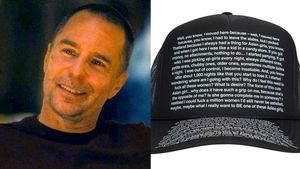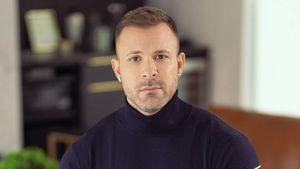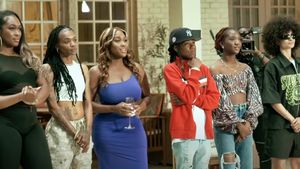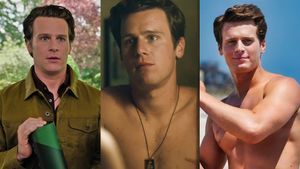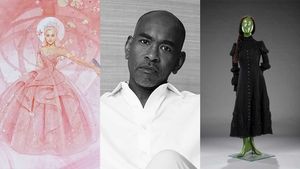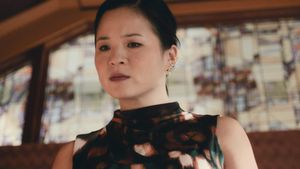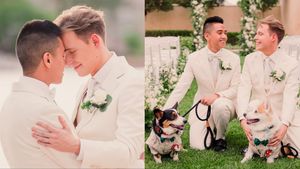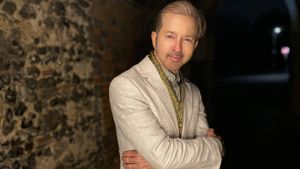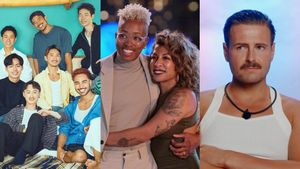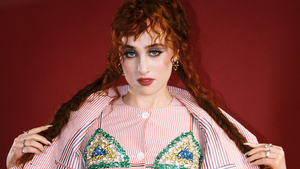One of fashion's biggest problems continues to be ignored every single time a person with a plus-size or noncisnormative figure isn't represented. The problem is called body positivity, and LGBT folks are often the ones facing it head-on when they are left out of the runway or from an advertising campaign, or not even given space for their size on the racks of stores. But two queer fashion insiders are hoping to change all that.
"It's hurting everyone, both people who strive to maintain the ultimate physique, but even more so for those whom that physique is unattainable," says Sonny Oram, editor in chief and founder of Qwear, a popular clothing blog that specializes in showcasing outfits from stylish, diverse LGBT people.
The notion of the "ultimate physique" Oram mentions will be familiar to everyone, skinny or large, cis or trans. Without knowing it, even those with conventionally attractive and celebrated bodies can find themselves racing against time to keep their looks or find it hard to compete with runway beauty standards. But the most marginalized, still, are the people who fall outside of the normative conception of beauty, especially when they are very much ignored in mainstream fashion for the size or look of their bodies.
"It hits trans women of color the hardest," Oram continues. "The murder rate against trans women of color is so high that some consider it an epidemic. When the media only shows images of the 'ideal gay,' it sends a message that if you are not a thin, young, white, handsome, cis gay guy, you don't matter. That message is what ostracizes people and perpetuates violence, both from individuals and institutions."
"In order for our society to create a safe environment ... we first need to believe that everyone matters," Oram says.
 Backstage at Qwear's Dismantle Me runway show at Rainbow Fashion Week.
Backstage at Qwear's Dismantle Me runway show at Rainbow Fashion Week.
"I think it's totally unfair," says Jillian Brooks, founder of online retailer Equal Period, a brand that specializes in selling affordable, trendy clothing to people of all sizes and gender identities. "I don't even think we know necessarily how those things are truly affecting us. When you're younger you don't even realize that these things are sort of compounding and impacting in your brain."
 From Equal Period's spring 2015 collection.
From Equal Period's spring 2015 collection.
To get to the root of why plus-size people are often excluded from the face of the style industry, one of the questions that needs to be asked is simple: What makes a "perfect body?" For men, it's the tall, dark, and handsome archetype, one that comes complete with muscles, maybe a little bit of facial hair, and an air of overt masculinity. For women, it's the idea of being slim yet curvy, with long, wavy hair, doe eyes, full lips, and a sense of being "naturally" feminine, despite the assistance of a plethora of beauty products.
According to a 2012 report by ABC News, the female models who walk the runways of major events like New York Fashion Week are usually a dress size 0 at the smallest and a size 4 at the largest, yet, the Centers for Disease Control and Prevention cite the average waist size of an American woman as about 37.5 inches, or around a size 18 dress size, according to many standardized retail sizing charts.
The conclusion? Retailers portray the "perfect body" as one that is much, much thinner than the reality of an average American. This causes an alienation among a majority of consumers, and one that is felt tenfold in the gender-nonconforming LGBT population, say Oram and Brooks.
But instead of buying into an oppressive system that is often marked by exclusivity, they are seeking to create spaces for other people like them in the fashion industry.
"A few months after college I made a brave step into the boys' department for the first time in my life. I'd been wishing I could shop there for years but the stigma and social pressure had made that step seem impossible. Once I started trying things on, I loved the way I looked for the first time in my life. A sudden interest in fashion followed," Oram says, recalling the inspiration for Qwear, a venture that not only includes editorial content but eventually featured an original clothing line called Dismantle Me, designed by Qwear's fashion director Ru (it presented at Rainbow Fashion Week this past June in New York City). "I wanted to help other queer people of all identities who had struggled to feel the empowerment I felt, so I began a blog."
 Backstage at Qwear's Dismantle Me runway show at Rainbow Fashion Week.
Backstage at Qwear's Dismantle Me runway show at Rainbow Fashion Week.
 Qwear writer/model LuzMarina Serrano posing for a feature.
Qwear writer/model LuzMarina Serrano posing for a feature.
"Years ago I had a very corporate job, and I struggled to find work-appropriate attire that fit me, but that I also felt good about myself in," Brooks says about the founding of Equal Period. "That kind of started to bring a lot of questions into my mind, and so I explored into the options for LGBTQA identifiers in the fashion industry, and there really wasn't much.
"The idea for Equal Period came from seeing that there was a little bit of a niche for affordable, comfortable, quality clothing that wasn't really defining gender, that wasn't really predetermining size constraints for people to try to fit into."
Brooks's company offers a wide array of trendy, gender-neutral basics from jogger pants and chambray tops, to T-shirts and sweaters. But what makes Equal Period different from most clothing lines is its original and expanded sizing guide, one that gives each size category a few more inches to achieve what Brooks describes as a truer fit for each of her customers.
"It's really made a difference for people," she says. "We've had quite a bit of exchanges, because people are ordering larges when they're really smalls, but it's also really pumped a lot of people up and made them feel really good about purchasing clothing with us."
 From Equal Period's spring 2015 collection.
From Equal Period's spring 2015 collection.
Equal Period's business model of inclusivity in sizing is unusual, especially when so many retailers try to be as exclusive in their customer base as possible. (What's the point of wanting -- and selling -- a product if everyone else can have it, right?)
One well-known company that epitomizes this "cool kid" notion is the infamous Abercrombie & Fitch. The fast fashion retailer that was once a staple in suburban malls is known for its provocative advertisements. And until April, Abercrombie store employees were called "models" and the chain was accused of hiring based on how attractive they were. Most women's clothing from Abercrombie also doesn't come in sizes bigger than large.
"To me, it's sort of a 'mean girl' mentality," Brooks theorizes. "It's like the Abercrombie & Fitch business. They want everyone who is wearing their products to be captain of the football team or head of the cheerleading squad, and that's only 1 percent of the population these days. It feels really kind of laughable that more organizations aren't putting systems in place for different types of body types, different types of individuals."
"I think, sadly, we kind of still operate on a culture of shame, even if it is very subtle," Brooks continues. "A lot of these retailers are worried that they lose some of their image or brand identity by offering a better variety of sizes or a separate category of their line that is designed for, honestly, more common body types."
"There are many factors at play here," says Oram, whose website profiles many different types of bodies in many different types of outfits. "Capitalism encourages body-shaming, because there is money to be made off of people's insecurities. The more the media tells people what beauty looks like and how beautiful is important, the more people will spend money to try to attain that beauty. This affects everyone, but particularly women, whose bodies are always under scrutiny."
So what will it take for designers and retail companies to realize that there is a demand for clothing for people of size, especially those within the LGBT spectrum? Unlike the reasons for exclusivity, the solution is a little more complex.
"Go outside. Look up. Go anywhere!" Brooks offers. "It's almost like walking with blinders on. Acknowledge that the Vitruvian sort of style guide for a person's body type is really out of date. It's just sort of a fact. It just feels very behind the times that we still kind of create for this what we call a 'perfect body type.' When you think about like what people really find attractive these days in another person, it's so rare that someone is saying Oh, their washboard abs! No one is saying those things anymore. So it feels silly that we put value in them in terms of clothing."
 From Equal Period's spring 2015 collection.
From Equal Period's spring 2015 collection.
"Expanding our notion of beauty to include different body types, colors, shapes, ages, etc. will help fight the beauty industry," says Oram. "But I also think we need to bring our focus away from beauty. I don't believe that basing self-worth off beauty makes anyone truly happy. We need to educate people about how to live healthy lives while both fighting against these messages and avoiding supporting the companies that perpetuate them. Companies can't stop feeding us lies if the lies no longer work. The LGBT community is just as guilty of body-shaming media as anyone else."
 Backstage at Qwear's Dismantle Me runway show at Rainbow Fashion Week.
Backstage at Qwear's Dismantle Me runway show at Rainbow Fashion Week.
"I think it's necessary for our health that we love our bodies and feel good about ourselves," Oram continues. "A society that gives people of size the message that they are worthless encourages eating disorders, depression, crash dieting, and lots of health issues. I would never deem to tell a demographic that they should feel or behave a certain way, because we live in a society where it is impossible to not be affected by body-shaming. I just hope to encourage people of all sizes to embrace themselves and be as happy and healthy as they can at the size that is right for them."
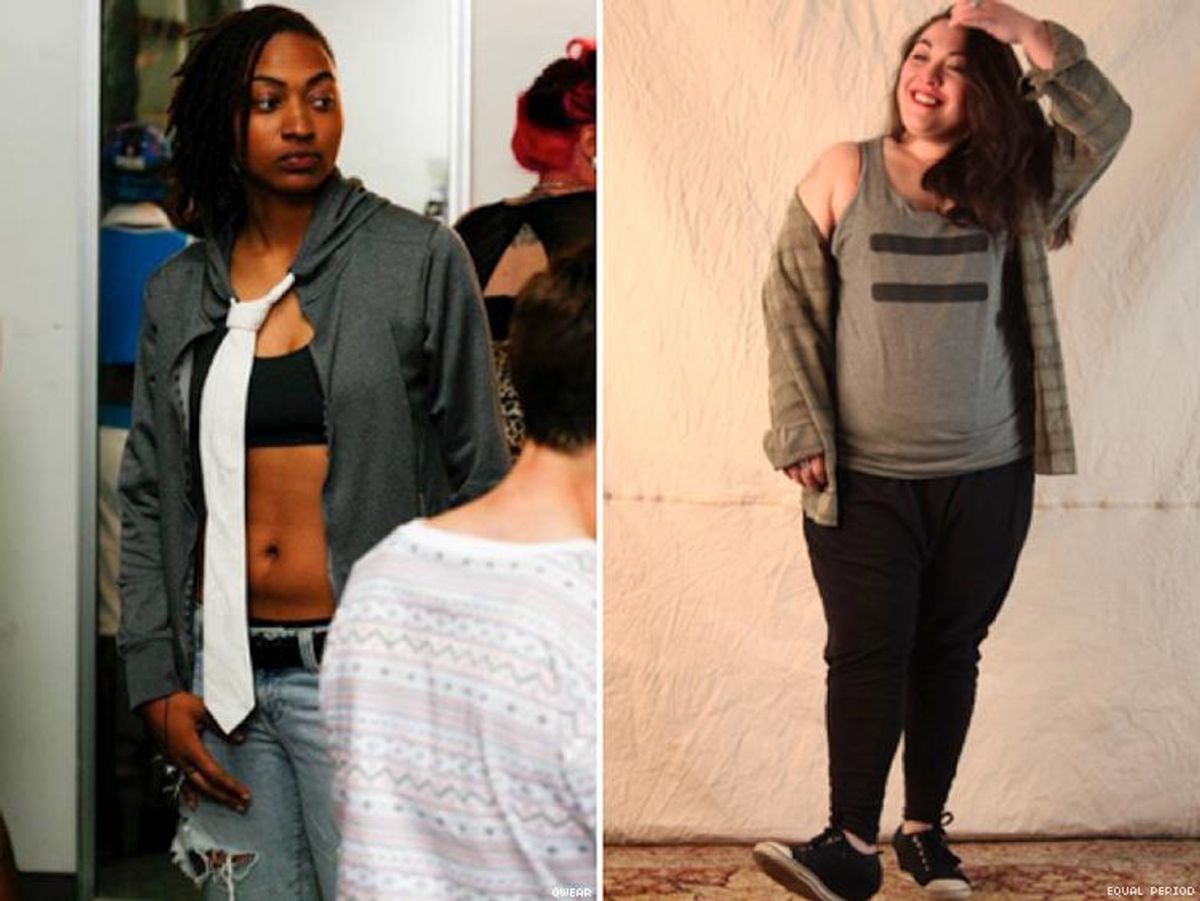

 Backstage at Qwear's Dismantle Me runway show at Rainbow Fashion Week.
Backstage at Qwear's Dismantle Me runway show at Rainbow Fashion Week. From Equal Period's spring 2015 collection.
From Equal Period's spring 2015 collection. Backstage at Qwear's Dismantle Me runway show at Rainbow Fashion Week.
Backstage at Qwear's Dismantle Me runway show at Rainbow Fashion Week. Qwear writer/model LuzMarina Serrano posing for a feature.
Qwear writer/model LuzMarina Serrano posing for a feature. From Equal Period's spring 2015 collection.
From Equal Period's spring 2015 collection. From Equal Period's spring 2015 collection.
From Equal Period's spring 2015 collection. Backstage at Qwear's Dismantle Me runway show at Rainbow Fashion Week.
Backstage at Qwear's Dismantle Me runway show at Rainbow Fashion Week.































